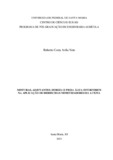| dc.creator | Avila Neto, Roberto Costa | |
| dc.date.accessioned | 2021-12-13T12:48:12Z | |
| dc.date.available | 2021-12-13T12:48:12Z | |
| dc.date.issued | 2021-01-28 | |
| dc.identifier.uri | http://repositorio.ufsm.br/handle/1/23262 | |
| dc.description.abstract | With the launching of Enlist® and Xtend® technologies and, consequently, the increased use of the herbicides 2,4-D and dicamba, new information about the technology of the application of these compounds must be generated, in order to guarantee a correct, safe and efficient. Therefore, the objective of this work was to study the role of the mixture between herbicides and pesticides of different classes in the physico-chemical compatibility of the spray and droplet spectrum; the use of adjuvants in efficiency, chemical aspects and droplet spectrum; and hardness and pH in the control of broadleaved weeds, in aspects of the application technology of auxin-mimicking herbicides. Three works were carried out between the years 2018 and 2020 in field and greenhouse. Overall, we observed the susceptibility of the herbicides 2,4-D and dicamba to pH change, either by mixing with other pesticides, adjuvants or initial pH of the water. In addition, the physical-chemical characteristics and droplet spectrum of these herbicides can be changed depending on the mixture performed. Also, in the production system with crops resistant to auxin-mimicking herbicides, the use of adjuvants, the pH value of the water and the time of preparation of the syrup are determining factors for the success of chemical control strategies, and priority should be given to time of application together with the proper preparation of the syrup and correct use of adjuvants. Based on this, it is evident the need to know the impact of the mixture of 2,4-D and dicamba with different classes of pesticides and the use of adjuvants in the spray, in addition to the role of water quality in the use of these herbicides, since these factors affect the quality and efficiency of the application. | eng |
| dc.description.sponsorship | Coordenação de Aperfeiçoamento de Pessoal de Nível Superior - CAPES | por |
| dc.language | por | por |
| dc.publisher | Universidade Federal de Santa Maria | por |
| dc.rights | Attribution-NonCommercial-NoDerivatives 4.0 International | * |
| dc.rights.uri | http://creativecommons.org/licenses/by-nc-nd/4.0/ | * |
| dc.subject | 2,4-D | por |
| dc.subject | Amina | por |
| dc.subject | Colina | por |
| dc.subject | Dicamba | por |
| dc.subject | Tecnologia da aplicação | por |
| dc.subject | Amine | eng |
| dc.subject | Choline | eng |
| dc.subject | Dicamba | eng |
| dc.subject | Application technology | eng |
| dc.title | Misturas, adjuvantes, dureza e pH da água interferem na aplicação de herbicidas mimetizadores da auxina | por |
| dc.title.alternative | Mixtures, adjuvants, water hardness and pH interfere with the application of auxin mimicking herbicides | eng |
| dc.type | Dissertação | por |
| dc.description.resumo | Com o advento das tecnologias Enlist® e Xtend® e consequentemente o aumento do uso dos herbicidas 2,4-D e dicamba. Novas informações sobre a tecnologia da aplicação desses compostos devem ser geradas, afim de assegurar uma aplicação correta, segura e eficiente. Ou seja, deve-se conhecer o impacto de práticas como a mistura com diferentes classes de pesticidas, uso de adjuvantes e o papel da qualidade da água na utilização desses herbicidas. Diante disso o objetivo desse trabalho foi estudar o papel da mistura entre herbicidas e pesticidas de diferentes classes na compatibilidade físico-químico da calda, espectro de gotas, do uso de adjuvantes na eficiência, aspectos químicos e espectro de gotas e da dureza e do pH no controle de plantas daninhas latifoliadas e em aspectos da tecnologia da aplicação de herbicidas mimetizadores da auxina. Foram realizados três trabalhos entre os anos de 2018 e 2020 entre campo e casa de vegetação. Observou-se no geral a suscetibilidade da calda dos herbicidas 2,4-D e dicamba de alteração do pH seja por meios de mistura com outros pesticidas, adjuvantes ou por valor presente na água. Além disso, as características fisico-quimico e espectro de gotas desses herbicidas podem ser alteradas. Também, no sistema de produção de culturas resistentes a herbicidas mimetizadores da auxina o uso de adjuvantes, o valor do pH e o tempo de preparo da calda podem ser fatores determinantes para o sucesso das estratégias de controle químico, devendo-se priorizar o momento da aplicação em conjunto com o preparo da calda e uso correto de adjuvantes. Contudo, no panorama atual de aumento do uso de herbicidas mimetizadores da auxina trazido pelo lançamento das tecnologias Enlist® e Xtend® essas informações são de grande importância para nortear o uso seguro e eficaz dessas ferramentas. Podendo evitar problemas operacionais, falhas de controle e também deriva. | por |
| dc.contributor.advisor1 | Melo, Adriano Arrué | |
| dc.contributor.advisor1Lattes | http://lattes.cnpq.br/2723323416837014 | por |
| dc.contributor.advisor-co1 | Ulguim, Andre da Rosa | |
| dc.contributor.referee1 | Nunes, Anderson Luis | |
| dc.creator.Lattes | http://lattes.cnpq.br/0298085453019765 | por |
| dc.publisher.country | Brasil | por |
| dc.publisher.department | Engenharia Agrícola | por |
| dc.publisher.initials | UFSM | por |
| dc.publisher.program | Programa de Pós-Graduação em Engenharia Agrícola | por |
| dc.subject.cnpq | CNPQ::CIENCIAS AGRARIAS::ENGENHARIA AGRICOLA | por |
| dc.publisher.unidade | Centro de Ciências Rurais | por |



